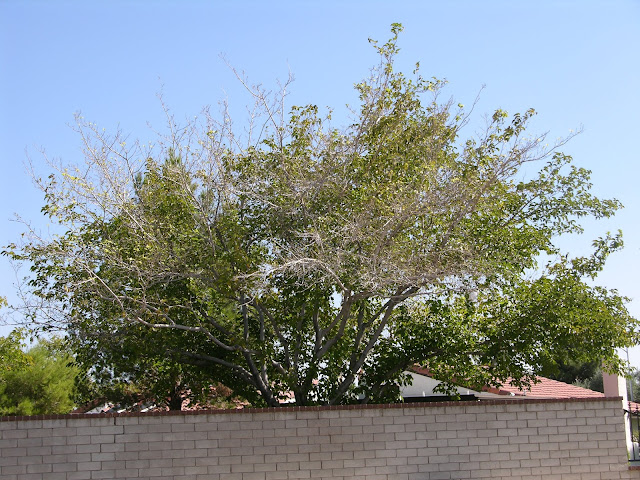Q. I am using an
inexpensive soil meter to help me judge went to water again. I redid my
landscape to include cacti, ocotillo, agaves and other types of desert plants.
Do I let my meter peg to 1 before watering again or is 2 to 3 okay?
A. I have promoted the use
of moisture meters for helping gardeners “get a handle” on when to water
plants. For non-desert plants, like many of our trees and shrubs, let the soil
moisture drop to about 50 -60 % before watering again. If the meter is divided
into 10 equal units, this would be about “6” on the meter’s scale.
The scales are relatively accurate
Desert plants that are not cacti, like Mesquite, Palo
Verde, Acacia and leafy succulents, the meter can drop a little bit lower than
this before watering; about 40-50% or about “5” on the same scale.
 |
| Another example of reading soil moisture with an inexpensive moisture meter.. |
Cacti is in a category by itself. I think you are about
right. Let the soil moisture drop to between “2-3” before watering again. Because
cacti store water inside their modified stems and leaves, they give a visual
indicator when their water is running out; the outside shrivels. That is a dead
giveaway it’s time to water.
 |
| A third example of using a soil moisture meter for gauging when to water again. |
When I am irrigating non-desert plants like fruit trees in
a soil that is new to me, I take three readings in different locations around
the tree and use the average. I don’t let any readings drop below “5” and I
will water if the average is about “6”. After I get the “rhythm” of seasonal
water use, I seldom need it after that.
Soil moisture meters I use alot for approximating soil moisture for irrigation
Reotemp Soil Moisture Meter Link
Lincoln soil moisture meter but the price has jumped up too high for me recently
Probes that are longer are more versatile
The other thing I do is push the probe of the meter into
the soil slowly. I want to measure soil moisture near the surface of the soil
and watch how it increases with depth. This technique helps me understand how
fast water is leaving the soil.
When to Water
There are two questions you need to answer when watering:
when to water and how much to apply. Soil moisture meters help mostly with the
“when” to water.
I judge how much water to apply by pushing a thin metal
rod, like 3/8 inch rebar, into the soil. It slips into the soil easily when it’s
wet. For trees and shrubs, apply enough water to penetrate 18 to 24 inches deep.
For lawns, flowerbeds and vegetable gardens, 12 inches deep. Two foot tall
shrubs, vines and groundcovers, 12 to 18 inches deep.
These are inexpensive meters andnot meant to last forever
when pushed into our soils. Once you get the “feel” for when, you won’t need it
often. Just occasionally when you aren’t sure.
Steps
1. Insert it in the soil slowly. Get moisture readings as you
slowly insert it into the soil. This gives you an idea how the soil is drying
out with depth. Newly planted seeds, trees, shrubs, need water frequently but
only a little. As they grow they need water less often (deeper) but more of it.
2. Take three soil measurements in different locations. Insert
it between emitters (if that is what you have). Otherwise insert it anywhere,
randomly, above the roots.
3. Observe your moisture meter readings as you slowly insert it
and at the depth of the roots. For flowers and grass, this will be about
(slowly) 6 inches deep. Remember that plant roots use water using the
40-30-20-10 rule…40% of the water they use is in the upper quarter of their
rooting depth, 30% from the second quarter, 20% from the third quarter and 10%
from the bottom quarter. If the plants are grass, flowers or vegetables the
roots are divided into upper quarter (zero to three inches deep), second
quarter (3-6 inches deep) third quarter (6-nine inches deep) and bottom quarter
(9-12 inches deep). Tree roots are 18 to 24 inches deep so adjust your
“quarters” to this depth. This is why it is important to push it into the soil
slowly.
4. Take three readings like this. Average them. Use this value
to determine when to water.
9-10 = Wet. Don’t water.
7-8 = Moist. Don't water.
5-6 = Water.
3-4 = Water desert plants
1-3 = Dry. Your plant is dead
unless it’s a cactus. Buy a new plant.
How much to water?
Look at
the size of the plant. Can you plant it in a 1 gallon container? Water it ½
gallon. Can you plant it in a two gallon container? Water it with one gallon of
water. Can you plant it in a 5 gallon bucket? Water it with 2 ½ gallons (round
it to 3 gallons). Got the idea?
 |
| 3/8 inch diameter rebar used for measuring irrigation depth inexpensively |
Trees and large shrubs are
more difficult to judge the container. Space emitters every 18 to 24 inches
apart under AT LEAST half of its canopy. Water long enough for the water to
drain 18 in deep. The easiest way to judge this is using a 3/8 in rebar,
pointed or sharpened (flat if you cant sharpen it) and push it into the soil
after you water. It will push easily to the same depth of the water.













